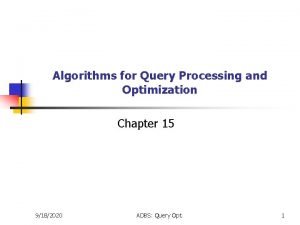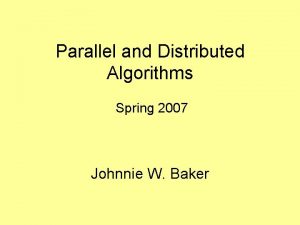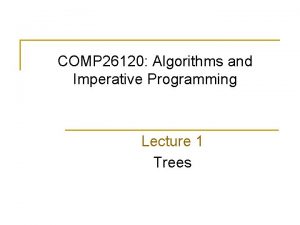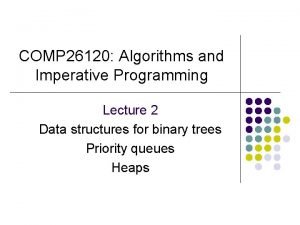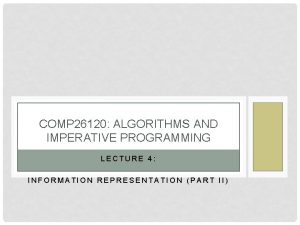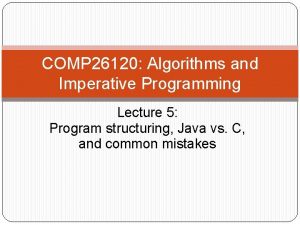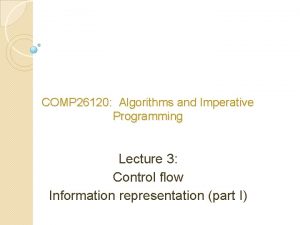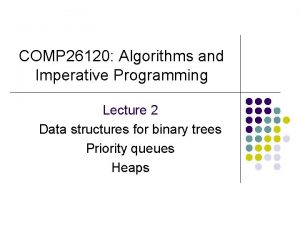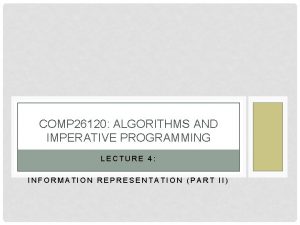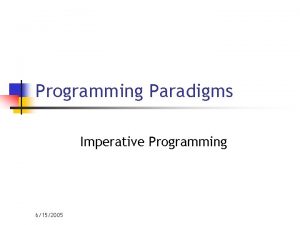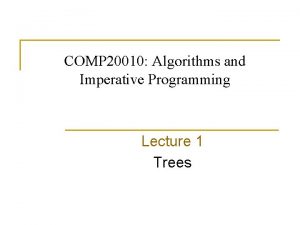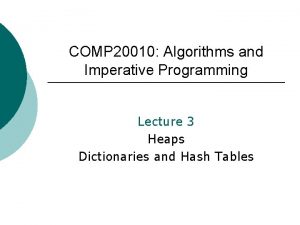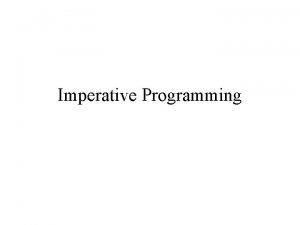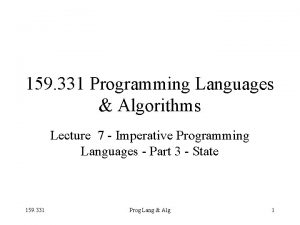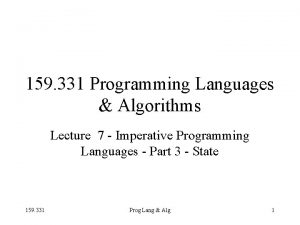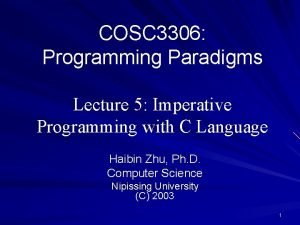COMP 26120 Algorithms and Imperative Programming Lecture 2




































- Slides: 36

COMP 26120: Algorithms and Imperative Programming Lecture 2 Data structures for binary trees Priority queues Heaps

Lecture outline l l l Different data structures for representing binary trees (vector-based, linked), linked structure for general trees; Priority queues (PQs); The heap data structure; Implementing priority queues as heaps; The vector representation of a heap and basic operations (insertion, removal);

Data structures for representing trees A vector-based data structure l l A vector-based structure for binary trees is based on a simple way of numbering the nodes of T. For every node v of T define an integer p(v): l l If v is the root, then p(v)=1; If v is the left child of the node u, then p(v)=2 p(u); If v is the right child of the node u, then p(v)=2 p(u)+1; The numbering function p(. ) is known as a level numbering of the nodes in a binary tree T.

Data structures for representing trees A vector-based data structure l ((((3+1)*3)/((9 -5)+2))-((3*(7 -4))+6)) 1 3 2 + / 5 4 + * 9 8 + 16 3 10 3 17 1 6 20 18 19 9 11 - 2 21 5 22 23 7 * 6 13 12 14 - 3 27 26 24 25 Binary tree level numbering 7 4 15

Data structures for representing trees A vector-based data structure l The level numbering suggests a representation of a binary tree T by a vector S, such that the node v from T is associated with an element S[p(v)]; 1 3 2 + / 5 4 + * 9 8 + 16 3 1 S 10 3 17 6 20 18 19 9 11 - * 6 13 12 2 31 14 - 3 21 5 22 23 - / + * 6+3 - 23 - 7 27 26 24 25 95 7 74 4 15

Data structures for representing trees A vector-based data structure Operation Time positions(), elements() O(n) swap. Elements(), replace. Element() O(1) root(), parent(), children() O(1) left. Child(), right. Child(), sibling() O(1) is. Internal(), is. External(), is. Root() O(1) Running times of the methods when a binary tree T is implemented as a vector

Data structures for representing trees A linked data structure l l l The vector implementation of a binary tree is fast and simple, but it may be space inefficient when the tree height is large (why? ); A natural way of representing a binary tree is to use a linked structure. Each node of T is represented by an object that references to the element v and the positions associated with its parent and children. parent element left child right child

Data structures for representing trees A linked data structure for binary trees null A A C B C null B null E D null F G F null G null

Data structures for representing trees A linked data structure for general trees l l Extends the previous data structure to the case of general trees; In order to register a potentially large number of children of a node, we need to use a container (a list or a vector) to store the children, instead of using instance variables; null A A B C D E C B null D null E null

Keys and the total order relation l l l In various applications it is frequently required to compare and rank objects according to some parameters or properties, called keys that are assigned to each object in a collection. A key is an object assigned to an element as a specific attribute that can be used to identify, rank or weight that element. A rule for comparing keys needs to be robustly defined (not contradicting). We need to define a total order relation, denoted by with the following properties: l Reflexive property: ; l Antisymmetric property: if and , then ; l Transitive property: if and , then ; The comparison rule that satisfies the above properties defines a linear ordering relationship among a set of keys. In a finite collection of elements with a defined total order relation we can define the smallest key as the key for which for any other key k in the collection.

Priority queues l l A priority queue P is a container of elements with keys associated to them at the time of insertion. Two fundamental methods of a priority queue P are: l l l insert. Item(k, e) – inserts an element e with a key k into P; remove. Min() – returns and removes from P an element with a smallest key; The priority queue ADT is simpler than that of the sequence ADT. This simplicity originates from the fact that the elements in a PQ are inserted and removed based on their keys, while the elements are inserted and removed from a sequence based on their positions and ranks.

Priority queues l l A comparator is an object that compares two keys. It is associated with a priority queue at the time of construction. A comparator method provides the following objects, each taking two keys and comparing them: l l l is. Less( ) – true if ; is. Less. Or. Equal. To( ) – true if ; is. Greater( ) – true if ; is. Greater. Or. Equal. To( ) – true if ; is. Comparable(k) – true if k can be compared;

The heap data structure l l l The aim is to provide a realisation of a priority queue that is efficient for both insertions and removals. This can be accomplished with a data structure called a heap, which enables to perform both insertions and removals in logarithmic time. The idea is to store the elements in a binary tree instead of a sequence.

The heap data structure l A heap is a binary tree that stores a collection of keys at its internal nodes that satisfies two additional properties: l l l A relational property (that affects how the keys are stored); A structural property; We assume a total order relationship on the keys. Heap-Order property: In a heap T for every node v other than a root, the key stored in v is greater or equal than the key stored at its parent. The consequence is that the keys encountered on a path from the root to an external node are in non-decreasing order and that a minimum key is always stored at the root. Complete binary tree property: A binary tree T with height h is complete if the levels 0 to h-1 have the maximum number of nodes (level i has nodes for i=0, …, h-1) and in the level h-1 all internal nodes are to the left of the external nodes.

The heap data structure 4 5 6 15 16 9 25 14 7 12 11 20 8 An example of a heap T storing 13 integer keys. The last node (the right-most, deepest internal node of T) is 8 in this case

Implementing a Priority Queue using a Heap l A heap-based priority queue consists of: l l l heap: a complete binary tree with keys that satisfy the heap-order property. The binary tree is implemented as a vector. last: A reference to the last node in T. For a vector implementation, last is an integer index to the vector element storing the last node of T. comp: A comparator that defines the total order relation among the keys. The comparator should maintain the minimal element at the root. A heap T with n keys has height. If the update operations on a heap can be performed in time proportional to its height, rather than to the number of its elements, then these operations will have complexity.

Implementing a Priority Queue using a Heap heap comp < = > (4, C) (5, A) (15, K) (16, X) (6, Z) (9, F) (25, J) (14, E) (7, Q) (12, H) (11, S) (20, B) (8, W) last

Insertion into the PQ implemented using a heap l l In order to store a new key-element pair (k, e) into T, we need to add a new node to T. To keep the complete tree property, the new node must become the last node of T. If a heap is implemented as a vector, the insertion node is added at index n+1, where n is the current size of the heap.

Up-heap bubbling after an insertion l l After the insertion of the element z into the tree T, it remains complete, but the heap-order property may be violated. Unless the new node is the root (the PQ was empty prior to the insertion), we compare keys k(z) and k(u) where u is the parent of z. If k(u)>k(z), the heap order property needs to be restored, which can locally be achieved by swapping the pairs (u, k(u)) and (z, k(z)), making the element pair (z, k(z)) to go up one level. This upward movement caused by swaps is referred to as up-heap-bubbling. In the worst case the up-heap-bubbling may cause the new element to move all the way to the root. Thus, the worst case running time of the method insert. Item() is proportional to the height of T, i. e , as T is complete.

Up-heap bubbling after insertion (an example) (4, C) (5, A) (15, K) (16, X) (6, Z) (9, F) (25, J) (14, E) (7, Q) (12, H) (11, S) (20, B) (8, W)

Up-heap bubbling after insertion (an example) (4, C) (5, A) (15, K) (16, X) (6, Z) (9, F) (25, J) (14, E) (7, Q) (12, H) (11, S) (20, B) (8, W) (2, T)

Up-heap bubbling after insertion (an example) (4, C) (5, A) (15, K) (16, X) (6, Z) (9, F) (25, J) (14, E) (7, Q) (12, H) (11, S) (20, B) (8, W) (2, T)

Up-heap bubbling after insertion (an example) (4, C) (5, A) (15, K) (16, X) (6, Z) (9, F) (25, J) (14, E) (7, Q) (12, H) (11, S) (2, T) (8, W) (20, B)

Up-heap bubbling after insertion (an example) (4, C) (5, A) (15, K) (16, X) (2, T) (9, F) (25, J) (14, E) (7, Q) (12, H) (11, S) (6, Z) (8, W) (20, B)

Up-heap bubbling after insertion (an example) (4, C) (5, A) (15, K) (16, X) (2, T) (9, F) (25, J) (14, E) (7, Q) (12, H) (11, S) (6, Z) (8, W) (20, B)

Up-heap bubbling after insertion (an example) (2, T) (5, A) (15, K) (16, X) (4, C) (9, F) (25, J) (14, E) (7, Q) (12, H) (11, S) (6, Z) (8, W) (20, B)

Up-heap bubbling after insertion (an example) (2, T) (5, A) (15, K) (16, X) (4, C) (9, F) (25, J) (14, E) (7, Q) (12, H) (11, S) (6, Z) (8, W) (20, B)

Removal from the PQ implemented as a heap l l We need to perform the method remove. Min() from the PQ. The element r with a smallest key is stored at the root of the heap. A simple deletion of this element would disrupt the binary tree structure. We access the last node in the tree, copy it to the root, and delete it. This makes T complete. However, these operations may violate the heap-order property.

Removal from the PQ implemented as a heap l To restore the heap-order property, we examine the root r of T. If this is the only node, the heap-order property is trivially satisfied. Otherwise, we distinguish two cases: l l l If the root has only the left child, let s be the left child; Otherwise, let s be the child of r with the smallest key; If k(r)>k(s), the heap-order property is restored by swapping locally the pairs stored at r and s. We should continue swapping down T until no violation of the heap-order property occurs. This downward swapping process is referred to as down -heap bubbling. A single swap either resolves the violation of the heaporder property or propagates it one level down the heap. The running time of the method remove. Min is thus.

Down-heap bubbling after removal (an example) (2, T) (5, A) (15, K) (16, X) (4, C) (9, F) (25, J) (14, E) (7, Q) (12, H) (11, S) (6, Z) (8, W) (20, B)

Down-heap bubbling after removal (an example) (2, T) (20, B) (5, A) (15, K) (16, X) (4, C) (9, F) (25, J) (14, E) (7, Q) (12, H) (11, S) (6, Z) (8, W)

Down-heap bubbling after removal (an example) (20, B) (5, A) (15, K) (16, X) (4, C) (9, F) (25, J) (14, E) (7, Q) (12, H) (11, S) (6, Z) (8, W)

Down-heap bubbling after removal (an example) (4, C) (20, B) (5, A) (15, K) (16, X) (9, F) (25, J) (14, E) (7, Q) (12, H) (11, S) (6, Z) (8, W)

Down-heap bubbling after removal (an example) (4, C) (5, A) (15, K) (16, X) (20, B) (9, F) (25, J) (14, E) (7, Q) (12, H) (11, S) (6, Z) (8, W)

Down-heap bubbling after removal (an example) (4, C) (5, A) (15, K) (16, X) (20, B) (6, Z) (9, F) (25, J) (14, E) (7, Q) (12, H) (11, S) (8, W)

Down-heap bubbling after removal (an example) (4, C) (5, A) (15, K) (16, X) (6, Z) (9, F) (25, J) (14, E) (7, Q) (12, H) (11, S) (20, B) (8, W)
 Analysis of algorithms lecture notes
Analysis of algorithms lecture notes Introduction to algorithms lecture notes
Introduction to algorithms lecture notes Computational thinking algorithms and programming
Computational thinking algorithms and programming Synchronization algorithms and concurrent programming
Synchronization algorithms and concurrent programming Dot product rules
Dot product rules 01:640:244 lecture notes - lecture 15: plat, idah, farad
01:640:244 lecture notes - lecture 15: plat, idah, farad Declarative statement in assembly language
Declarative statement in assembly language Imperative programming languages
Imperative programming languages Forward reference table frt is arranged like
Forward reference table frt is arranged like For imperative statement 2 pass assembler
For imperative statement 2 pass assembler C programming lecture
C programming lecture Perbedaan linear programming dan integer programming
Perbedaan linear programming dan integer programming Greedy algorithm vs dynamic programming
Greedy algorithm vs dynamic programming System programming vs application programming
System programming vs application programming Integer programming vs linear programming
Integer programming vs linear programming Definisi linear
Definisi linear Design and analysis of algorithms syllabus
Design and analysis of algorithms syllabus Data structures and algorithms iit bombay
Data structures and algorithms iit bombay Association analysis: basic concepts and algorithms
Association analysis: basic concepts and algorithms Computer arithmetic: algorithms and hardware designs
Computer arithmetic: algorithms and hardware designs Kevin wayne princeton
Kevin wayne princeton Data structures and algorithms tutorial
Data structures and algorithms tutorial Algorithms for select and join operations
Algorithms for select and join operations Algorithms and flowcharts
Algorithms and flowcharts Undecidable problems and unreasonable time algorithms.
Undecidable problems and unreasonable time algorithms. Information retrieval data structures and algorithms
Information retrieval data structures and algorithms Data structures and algorithms bits pilani
Data structures and algorithms bits pilani Cluster analysis basic concepts and algorithms
Cluster analysis basic concepts and algorithms Randomized algorithms and probabilistic analysis
Randomized algorithms and probabilistic analysis Introduction of design and analysis of algorithms
Introduction of design and analysis of algorithms Algorithms for query processing and optimization
Algorithms for query processing and optimization Parallel and distributed algorithms
Parallel and distributed algorithms Data structures and algorithms iit bombay
Data structures and algorithms iit bombay Cluster analysis basic concepts and algorithms
Cluster analysis basic concepts and algorithms Cjih
Cjih Algorithm for recovery and isolation exploiting semantics
Algorithm for recovery and isolation exploiting semantics Dsp algorithms and architecture notes
Dsp algorithms and architecture notes






























